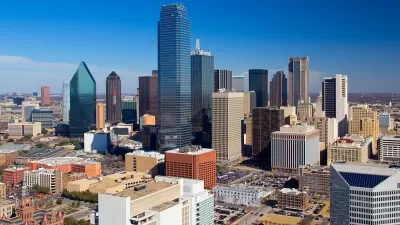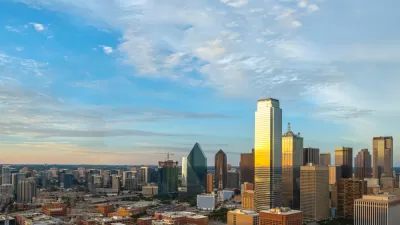The big, contentious question of contemporary downtowns is under consideration in Dallas: Is there too much parking or not enough parking?

Robert Wilonsky recently reported that the city of Dallas is seeking consultants to study Downtown Dallas' parking needs and develop a plan to meet parking demands. According to Wilonsky, "[t]he request for qualifications…blames a lack of parking on some companies choosing to move to the suburbs rather than the city center." The RFQ elaborates on how the rebirth of downtown "into a globally competitive urban center has placed strains on the ability to meet parking demands and expectations, resulting in some desired investment and development choosing to forego downtown Dallas for locations in outlying suburban areas."
The parking plan follows from the update of the Downtown Dallas 360 plan, approved in 2011 and currently amidst an update. Wilonsky notes that the city is also underway with a study examining on-street parking and about to launch another parking study in the Bishop Arts District neighborhood.
Enter Mark Lamster, Dallas Morning News architecture critic, who provides his critical take on the trends favoring parking in downtown: "This is not the best use for such precious spaces with the urban center." Lamster is bluntly skeptical that the city's new study will achieve anything other than more reinforcement for the parking status quo: "What it will do is reinforce the cycle of looping logic that has bred the very problem it would resolve. Because downtown Dallas doesn’t principally have a parking problem. It has a downtown Dallas problem, and the parking situation is only an exacerbating consequence of that reality."
Lamster provides a long list of specific shortcomings in the public realm of downtown to elaborate that point that it will take much more than a parking study to understand parking in Dallas.
Peter Simek follows Lamster's commentary with some of his own, including the additional point that the city's downtown buildings suffer from historically low vacancy rates, which creates a catch-22 of parking demand.
FULL STORY: Dallas is ready to pay someone to find out if the city has enough downtown parking spaces

Maui's Vacation Rental Debate Turns Ugly
Verbal attacks, misinformation campaigns and fistfights plague a high-stakes debate to convert thousands of vacation rentals into long-term housing.

Planetizen Federal Action Tracker
A weekly monitor of how Trump’s orders and actions are impacting planners and planning in America.

San Francisco Suspends Traffic Calming Amidst Record Deaths
Citing “a challenging fiscal landscape,” the city will cease the program on the heels of 42 traffic deaths, including 24 pedestrians.

Defunct Pittsburgh Power Plant to Become Residential Tower
A decommissioned steam heat plant will be redeveloped into almost 100 affordable housing units.

Trump Prompts Restructuring of Transportation Research Board in “Unprecedented Overreach”
The TRB has eliminated more than half of its committees including those focused on climate, equity, and cities.

Amtrak Rolls Out New Orleans to Alabama “Mardi Gras” Train
The new service will operate morning and evening departures between Mobile and New Orleans.
Urban Design for Planners 1: Software Tools
This six-course series explores essential urban design concepts using open source software and equips planners with the tools they need to participate fully in the urban design process.
Planning for Universal Design
Learn the tools for implementing Universal Design in planning regulations.
Heyer Gruel & Associates PA
JM Goldson LLC
Custer County Colorado
City of Camden Redevelopment Agency
City of Astoria
Transportation Research & Education Center (TREC) at Portland State University
Jefferson Parish Government
Camden Redevelopment Agency
City of Claremont





























